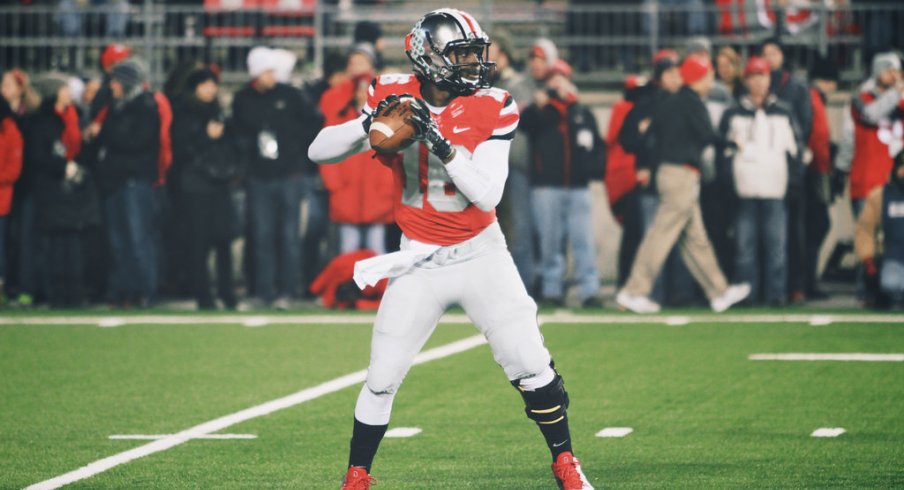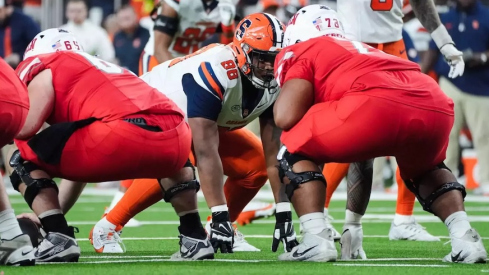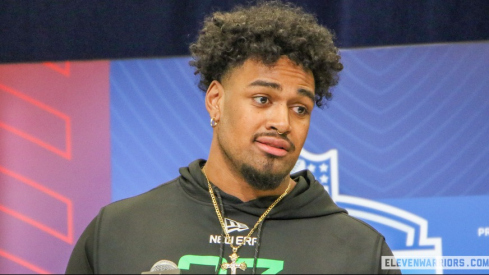Ohio State used its 55-14 win over Illionis as a tune-up for its much-anticipated showdown against Michigan State. On offense the Buckeyes broke tendencies, while the Ohio State defense transitioned from playing sound to playing aggressively.
To win in East Lansing, the Buckeye offense will need a better passing performance from JT Barrett, while taking advantage of the Spartan inexperience in their boundary defense. And Ohio State must limit the Michigan State run game.
Step by Step
Ohio State's defense continues its growth in Chris Ash's 4-3 over, cover 4 scheme. In the season's first month, the Buckeyes had sporadic breakdowns that allowed explosive plays. In October, the defense was increasingly sound in coverage and leveraging the football.
Against Illinois, Ohio State combined sound assignment football with aggressive play. By having an identity and constantly repping the same system, the Buckeyes have replaced playing with tenativeness to with playing without thinking.
This is most noticeable against screen plays that were a constant irritant last season.
But it is also apparent in how well the back seven is reacting to pattern distribution in cover 4 and playing the football within that framework.
Of course, it does not hurt to have a dominant player in Joey Bosa. Earlier this season Bosa too often free lanced, resulting in a loss of contain.
But he is now controlling games within the defensive framework. In gameplanning for Ohio State, every opposing coach must first determine how they will account for Bosa. And Ash makes that more difficult by moving Bosa around -- particularly by bumping him inside on third down.
Ohio State is likewise getting stellar play from Darron Lee. Lee inhabits the critical walkout linebacker position, meaning that he must control the wide-side flat against both the run and the pass. His play and Will linebacker Josh Perry's improvement has turned the linebacking corps from a weakness into a competent unit. The Buckeyes are also receiving solid contributions from seniors Curtis Grant and Steve Miller.
Test Time
It is of course easy to discount the Buckeye defensive improvement by pointing out that Illinois is a bad team. But Ohio State surrendered a number of points to bad teams -- including an equally bad Illinois team -- last season. The difference now is that the Buckeye defense is causing turnovers and forcing teams to drive the length of the field. In fact, Ohio State has only allowed 16 plays of 20 yards or longer -- tied with Stanford for best in the FBS.
The Buckeye defense faces a much stiffer test in an experienced Spartans' offense. Opposing offenses have been unwilling or unable to run the football against Ohio State.
But Michigan State will undoubtably believe they can run with tailback Jeremy Langford behind a veteran offensive line. The strength of the Buckeye defense remains the defensive front. They must control the line of scrimmage. Quarterback Connor Cook is dangerous off play-action with a running game and ample protection. But he is prone to mistakes if he tries to force throws.
The Spartan offense has been more successful scoring off explosive plays than sustaining drives. Such explosive plays often come from wide receiver Tony Lippett off play-action. Play action is obviously more effective when a team is successfully running the football.
So the Buckeyes must make Michigan State one-dimensional and then use Ash's zone blitz scheme. One matchup to watch early will be how the Spartans attempt to account for Bosa.
We Talkin' About Practice
On offense, Urban Meyer and Tom Herman used the outing against Illinois as a glorified scrimmage. The Buckeye coaching staff's primary goal was breaking tendencies in preparation for Pat Narduzzi's defense.
For instance, the Buckeyes rarely ran tight zone towards the tight end. Instead, from an offset half back, Ohio State ran outside, using sweep read. As Kyle detailed, with sweep read -- depending upon which linemen is uncovered, two of the three offensive linemen -- the center, playside guard and playside tackle -- will pull. The quarterback holds the backside defender with a read.
Likewise, the Buckeyes ran counters off tight zone and frequently threw in short-yardage -- all in an attempt to break tendencies.
Meyer and Herman also sought repetitions for a passing game that struggled against Penn State with only 2.5 yards per passing attempt. Barrett again struggled early against Illinois. Although his running seemed unaffected, he was tentative in planting his front throwing leg with the sprained MCL. The result was sailing the football over the head of open receivers.
But Barrett became more comfortable with his left knee as the game progressed. And as he became more comfortable planting his front foot his accuracy improved.
Given his arm limitations, Barrett also demonstrated why it is so important that he throw in rhythm. Against the Nittany Lions, Barrett double clutched and threw late downfield. This resulted in under thrown receivers and pass break-ups by defensive backs who had time to recover.
But against Illinois, Barrett threw several deep balls in time, allowing Devin Smith to run to the football.
And Smith demonstrated why he is so important to the Buckeye offense. He is the one receiver that can take the top off the defense. And he has the talent to catch contested throws. As it was in 2012, Smith's deep play ability will be crucial against the Spartans.
On a larger note, Saturday reinforced that the Buckeye offense has six critical tailbacks and wide receivers. This includes Smith and Michael Thomas on the outside, the two H-receivers Jalin Marshall and Dontre Wilson, and two tailbacks in Ezekiel Elliot and Curtis Samuel. The Buckeyes also have two reliable tight ends.
While none of them are going to force defenses to significantly alter their game plan, they provide Meyer and Herman options. Against Illinois, each of these six skill players created at least one explosive play. After only one play over 20 yards against Penn State, it is imperative for the Buckeyes that these big plays continue.
And it underscores why Samuel should continue to have a critical role -- as he is a threat to break runs to the second-level. Wilson is also increasingly showing a knack for getting open to the corner from the slot. Unfortunately Barrett overthrew him several times Saturday. But the opportunity for explosive plays from such routes will be critical against Michigan State's cover 4.
Boundary Games
We (and others) have extensively analyzed Narduzzi's 4-3 over, cover 4 defense. The Michigan State defense is again very good -- but not as statistically dominant as last year. According to Football Outsiders, the Spartans are first in the nation at preventing drives of 10+ plays and second in first downs allowed. But they are 87th in the country in opponent drives that average over 10+ yards per play -- meaning that they are vulnerable to ceding explosive plays.
This results from inexperience at several positions -- most notably field corner, nose guard, and boundary safety. At the latter two positions the Spartans frequently play true freshman Malik McDowell and Montae Nicholson.
Inexperience in the secondary of Narduzzi's cover 4 scheme can be particularly problematic. By its nature, the scheme is aggressive and requires proper safety reads. When a defensive back is fooled it can result in big plays.
Oregon attacked the Spartans' inexperience at these positions. The Ducks spread the Spartans out to the wide field and then ran power and tight zone into the boundary. This provided Oregon a double team against Michigan State's one-technique nose guard away from the over front and left the boundary safety as the only force player.
From there, the Ducks exploited the Spartan safeties with constraint plays that left the Spartan cover 4 safeties with difficult hi-lo reads. For instance, Oregon faked a jet sweep and threw a vertical seam route.
Similarly, the Ducks twice faked swing passes to the running back to set-up switch routes for big plays. Switch routes are particularly effective against cover 4 by forcing the corner and safety to switch man coverage between the crossing receivers.
Concededly, Oregon has one of the top offenses in the country. And Marcus Mariotta had numerous outstanding individual efforts evading pressure. But a far less talented Purdue team had similar success conflicting the Spartan safeties by combining a horizontal threat with vertical routes from inside receivers.
So Ohio State should have the opportunity to run the football inside. But they will need to create explosive plays against the Spartan secondary. To do so, the Buckeye interior offensive line must handle Michigan State's blitz pressure, particularly Narduzzi's favored double-A gap blitz. And Barrett must play more consistently and hit vertical opportunities when they are available.
The Buckeyes have been successful with swing routes to the running backs. Like Oregon, look for Meyer and Herman to use such routes to set up Michigan State for throws to Smith over the top.


